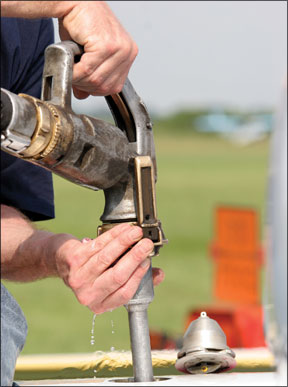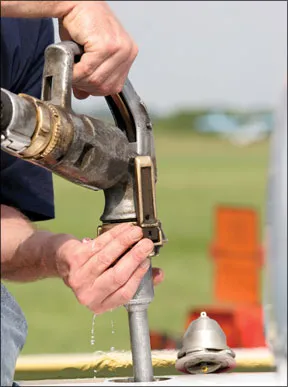Some time ago there was an Internet debate on running a tank dry. Each side had some valid arguments and thought the opposing view was absurd. Debates are like that. One side was convinced airplanes would be falling out of the sky if pilots

288
starting running tanks dry, then switching to one with fuel in it. The other side felt that airplanes would be falling out of the sky if pilots didnt run a tank dry, if for no other reason than to verify capacity. As such arguments go, both sides were right. And wrong.
But both sides agreed on a central point: Theres no substitute for thorough knowledge and understanding of your airplanes fuel system. With that goal in mind, lets set aside the other arguments for a moment, take a look at what goes into fuel systems and what we as pilots should know about them.
Tanks and Gauges
There are three common types of fuel tanks: wet wing, rigid fuel tank and bladder. Mooneys and other designs use a wet wing. Since the wing is a big hollow space why not just seal it up and let it hold the fuel? Perhaps the biggest concern with a wet wing is leakage. The wing skin is also the tank skin and wings flex, so its a challenge to keep those joints and all the hundreds of rivet holes sealed. Eventually, itll leak. Wet wings also have a reputation for being less safe in a crash-if the wing is even just bent, it could cause a tank rupture.
Some rigid tanks use existing structures like a large tubular main-spar-Grumman singles-and just seal it, while others design an area to accommodate a separate aluminum or composite fuel tank (many Cessna singles). Like a wet wing, rigid tanks will eventually leak, and may require significant effort to access for repair.
Bladders provide the most flexibility. A large enough area must still be designed to accommodate the bladder, but the shape can be irregular and theres no sealing problem between flexing metal panels. Also, theyre usually easier to get out for maintenance. Bladders, like wet wings and rigid tanks, have a good long life, but will eventually dry out, crack and leak. Keep fuel in them and they last longer.
Early fuel gauges consisted of little more than a flag stuck in a cork floating on the fuel. Flag position showed the amount of fuel. Another popular simple method was a sight glass that is a clear tube attached at the top and bottom of the fuel tank. You knew how much fuel you had by simply looking at it in the tube. Next, imagine something like the float in a toilet tank. Connect the pivot end to a variable resistor, send a small electrical signal through it and display the varying signals as fuel level on an electrical gauge, and youve got an electrical float gauge.
The visible float, sight glass and the electrical float are all basic indicators that provide a reasonably accurate reading when the plane is stable in a particular attitude. Try to read the gauge in turbulence or a prolonged climb, descent or turn and all accuracy bets are off. Plus, if the tank itself has any irregular shape, the gauge readings will not be linear. For instance, the first 25 percent of the fuel might show half-scale on the gauge. Non-linearity and instability require care to maintain an accurate mental picture of fuel quantity. Often times, a clock is your best fuel gauge.
The most sophisticated and typically accurate fuel gauge is a capacitance type where there are one or more probes in the tank that are electrically connected to circuitry that measures electrical properties of the contents of the tank that change with the amount of fuel vs. the amount of air in the tank. Capacitance fuel sensors are typically used on more sophisticated GA aircraft and on most turbines. One big difference is that they tend to measure the mass of the fuel rather than the volume. With a gauge that measures the fuel level, you can get different readings based on the expansion and contraction with temperature change. Capacitance type fuel measurement are somewhat immune to these vagaries.
Plumbing
Now, weve got a tank and a fuel gauge. Next, weve got to get that fuel to the engine. Engines, of course, have their own mechanical fuel pumps, but a backup is a good idea. High-wing Cessnas simply use gravity. Low-wing aircraft usually require an electric fuel pump.
One common GA fuel pump is a simple rotary pump with motor-driven vanes rotating inside a chamber, physically moving the fuel from the inlet to the outlet. Another is a vibrating pump that works much like the piston in an engine with the piston also being part of a simple vibrating mechanism such as those used on buzzers or an old-fashioned alarm clapper. Most small aircraft use a vibrating type where you can hear the clicking that starts fast and then slows as pressure builds. These vibrating pumps are less expensive but pump lower volumes than a rotating pump.
Simple…
If there were prizes for the simplest and most complex fuel systems in general aviation aircraft, Cessna might well win them both. The venerable Cessna 172 has probably the most common simple system with rigid metal tanks in the wings that gravity feed to the engine. The valves are as simple as it gets: Left, Both, Right, Off.
Cessnas low wing twins, on the other hand, might take the prize for the most complex fuel systems. Well take a look at the 340 specifically, although most Cessna twins are similar. This makes a good example because if you can master this one, you can handle any other GA fuel system in use today.
Well interject here that its important to understand your fuel system for what we hope are obvious reasons. Continued proper delivery of fuel to the engine(s) is one of the most critical elements in the safety of flight. To assure that delivery, one needs to properly manage the fuel system, and to do so it helps to know how the components fit together.
…Or Complex?
The Cessna 340 (see the schematic on the opposite page) can have up to six separate fuel tanks to actively manage. One might think the main tanks are in the wings, but instead, theyre tip tanks. Think of these as exposed rigid tanks. Next are the auxiliary tanks that are bladders in the wings. Each is actually two separate interconnected bladders with single fill point that work as one. There is an optional auxiliary bladder tank behind the firewall in each engine nacelle.
To reach all this fuel, the pilot has to manage valves, fuel boost and transfer pumps. The fuel valves in the cockpit allow the pilot to feed fuel to the engines from either the main or the wing aux tank (or cross-side main). The airplane is equipped with two-speed rotary electric boost pumps for each engine that pump over 50 gallons per minute (gpm). Each tip tank has a vibrating pump just to keep the fuel moving and prevent unporting of the fuel outlet. Each wing aux tank has a rotary pump that comes on automatically whenever the tank is selected to provide needed head pressure to assist the boost pumps.
Boost pumps need to deliver all the fuel needs of an engine. Thus, theyre typically designed with a capacity far greater than will ever be needed by the engine and that excess fuel has to go somewhere. In the 340, engineers could have doubled the selector valve to switch an excess return fuel line to the selected tank. Instead, the excess return goes only to the main. See the potential problem? Youd better use fuel from the mains first to make room for the return when youre using fuel from the wing aux tanks. If you dont, you risk dumping a lot of very expensive fuel-or worse, if you need that fuel to reach your destination.
To use the nacelle aux tanks youve got a vibrating electric pump that transfers that fuel to the main. With the pump running, there is an indicator that comes on when the transfer pressure is low, indicating (usually) a completed transfer. Dont forget to turn off the transfer pump.
Heres how you use all this: Take off on the mains, burn them down about halfway and switch to the wing aux tanks. When theyre nearly empty, the mains will be nearly full again. Switch back to the mains and burn them down a bit, then start the transfer from the nacelle aux tank. Monitor the light telling you the transfer is complete and turn off the transfer pump. To help with all this, Cessna did supply capacitance type fuel gauges for the mains and the wing aux tanks that read the tank in use, but theres no gauge on the nacelle aux tanks.
High and Dry
Finally, were back to whether or not to run a tank dry. Proponents say that if you do, youll better know how much is left and youll be better able to manage your fuel supply. However, you also run the risk of drawing detritus from the bottom of the tank into the fuel lines. Plus, it may be difficult to restart the engine when it quits at altitude. But, if youre going to leave a few gallons in each tank to avoid running it dry, with as many as six tanks you could end up with a meaningful quantity of “unusable” fuel. Granted, in a single you wont find a system as complex as that in our 340, but the same points apply.
We think both positions have merit. However, were going to advocate for occasionally running a tank dry when maximum range is required. Take a typical single with only left and right main tanks. Take off on, say, the left. Time it and use about half the fuel. Then switch to the right when youre at cruise and run it dry. Time that. If you subtract the time out of the left tank from the endurance of the right, youve got a good idea of the endurance remaining in the left (assuming the descent fuel flow averages out the climb fuel flow). Were not too concerned about debris from the tank causing a blockage because if there were that much crud in there it wouldnt take sucking the tank dry to become a problem. Restarting the engine isnt a problem if you act reasonably quickly. The only argument we cant counter is that if a valve failure makes it impossible to switch tanks, you dont want to find out with a dry tank. While this can certainly happen, a little care in checking the valve on the ground can go along way to making sure it wont happen in flight.
If youre going to run a tank dry, you should first tell your passengers to prevent alarm. Then, as the end nears, you must monitor it carefully and be poised for a quick tank switch: boost pump on, switch tanks, monitor, pump off. You should be able to make the switch in just a couple seconds. If you act quickly, the engine wont completely starve and youll only suffer a few seconds of rough running.
Study your fuel system. Know its demands. Know how it operates and its idiosyncrasies. Oh, and it shouldnt hurt to occasionally run a tank completely dry if youre going for maximum range or validating capacity.
Frank Bowlin flies CRJs for a large regional airline and is an independent CFI in Watsonville, Calif.




